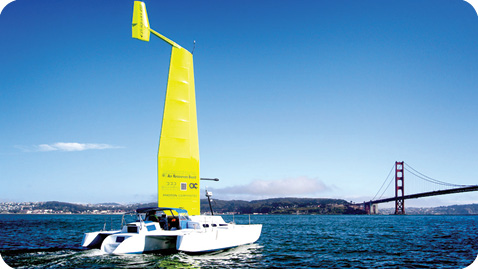
The catamaran, a technology demonstrator, tests the Wind+Wing Technologies’ wing sails in San Francisco Bay.
The guys at Wind + Wing Technologies are putting a new spin on one of the oldest applications of wind power: sailing. Inspired by the inefficient and environmentally harmful diesel-powered ferry system of the San Fransisco Bay, co-founders Jay Gardner and Hans Korfin, in a partnership with Photon Composites, have developed a carbon fiber sail system to supplement the energy requirements of large marine passenger vessels.
The entire system is powered by a single photovoltaic cell embedded into the 45-foot, 600-pound wing. A vessel data recording system and GPS guidance monitors conditions and adjusts the wing accordingly, which means no special sailing ability or crew is required to operate the vessel. The wing can be turned on and off with the press of a button.
The feathering tail system serves a similar function to the tail on an airplane. When optimal wind conditions are present the tail moves the wing into position to generate thrust. When wind conditions are no longer ideal, the tail is allowed to feather, and the wing moves to a position generating minimal drag.
Launched in January 2014, the demonstration vessel followed the erry routes and generated data on fuel efficiency and cost savings. The hybrid system is not intended to replace the use of fossil fuels altogether, but according to Wind + Wing, preliminary results show fossil fuel requirements were reduced by 40%. Further data is undergoing review at the University of California, Berkeley.
The goal is to retrofit current ferries or ideally include the wing as part of new ferry builds. The hard sail is already working for land and sea races such as last year’s America’s Cup sailing. The cost of the sail is estimated at $250,000 and according to the developers, it pays for itself in a few years. WPE&D

Filed Under: News, Policy






Most of the San Francisco ferry routes go right through the windiest part of San Francisco Bay, the so-called “Slot”. This is the area directly downwind (east) of the Golden Gate Bridge. Some of the tourist ferries operate almost exclusively in this windy area and this is the most popular area for sailors and regattas due to the wind resource. This is great technology to develop and wish WWT the best of luck in reducing diesel emissions with wind power.
We have restricted our self to primitive style usage of wind energy, merely asking wind to “push” we have refined systems to help in this regard.
I feel wind energy can be instantaneously transferred in mechanical form which can drive propellers or alternators, don’t get confused with 3blade giant’s commonly seen, this is an tested system with further improvements to optimize outcome. Details pending due prototype development consideration.
Shahid